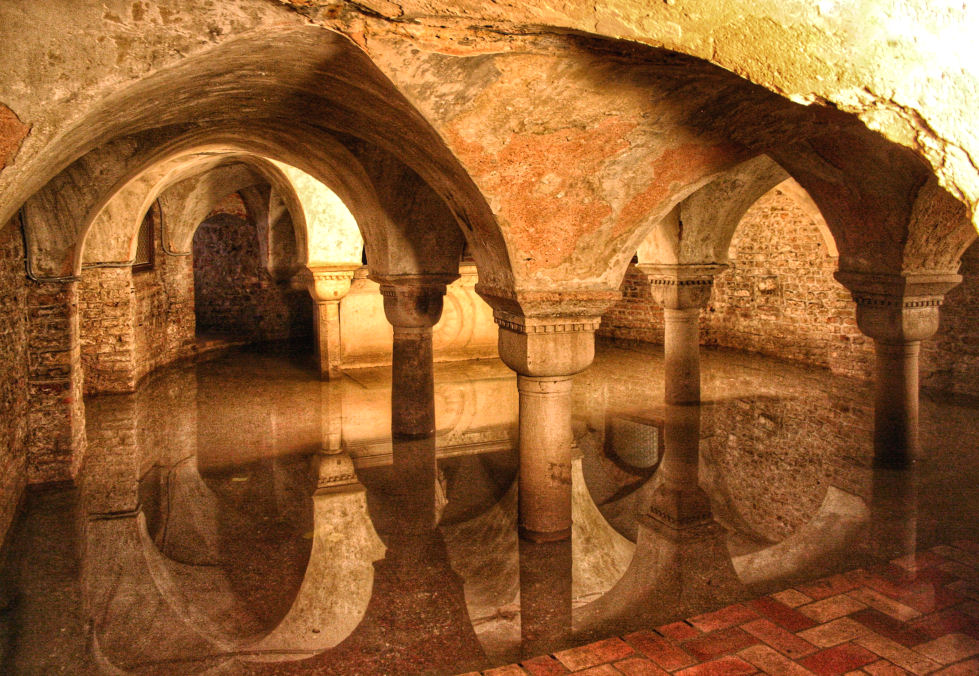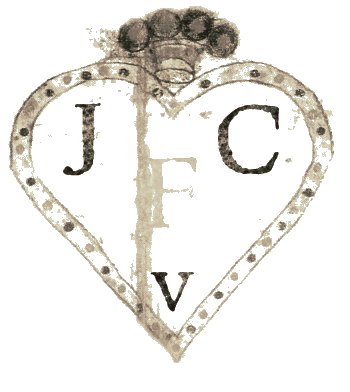|
History
The original church on this site was said to have been one of those founded
by San Magno (Saint Magnus) in the 7th century. One
was certainly built here by Doge Agnello Partecipazio in 828. It was
dedicated to Zacharias, the father of John
the Baptist,
whose relics were sent as a gift to Venice by the Byzantine
Emperor Leo V while the church was being built - these are
under the second altar on the right. The convent of Benedictine nuns next
door is said to have been built at the same time and was for a while the
only convent in Venice, and many of its abbesses were the daughters of
doges.
The church and convent were historically closely connected with the doge –
he processed to the church every Easter Monday. On 13th September 864, after
attending vespers at the church, Doge Pietro Tradinico was set upon by
conspirators at the entrance gateway to Campo San Zaccaria and left to
die. The ensuing riot meant that fearful nuns had to wait until nightfall
to retrieve his body for burial. It was on this visit that Doge Tradinico
had been given the corno ducale the cap which all doges since have
worn. (In fact a total of three doges have been assassinated in the
streets around San Zaccaria.) Many doges were buried her from the mid-9th
to the late-12th centuries. The original 9th-century basilica was
built over in the 10th-12th centuries. It’s said that the original church
burnt down in the fire of 1105, with a hundred nuns suffocated.
Later the nuns sacrificed their orchard (for cash) to facilitate the
creation of Piazza San Marco by Doge Sebastiano Ziani. This work also saw
the demolition of the original church of
San Geminiano, which was in the
middle of the planned piazza, with the nun's orchard laying between it and
the lagoon and so taking up most of the space that the Piazza was to
cover. It’s not surprising then, given this connection, that the state
paid for the building of the San Zaccaria we see today. It was also favoured
with having the campo in front declared private property with gates
closing its two entrances. The convent was famous for the wealth and
licentiousness of its pampered and high-born nuns, which might also
explain those gates. The current church and convent were built by Gambello from
1444-65. Gambello died in 1481 and work was completed by Codussi from
1483-1504. The church was consecrated in 1543
The church
The 15th century church you see as you enter the campo is therefore
the third on the
site. The façade of the old gothic church is visible to the right of
the current church's façade, along with the attached Benedictine convent
complex,
which was closed down by Napoleon and is now a Carabinieri barracks. The
16th century colonnade to the left of the church (possibly by Codussi and
now walled up) was built over the original convent cemetery. The
truly special monumental façade of the main church shows the transition from late gothic
to renaissance, as Gambello’s lower two levels are surmounted by Codussi’s
more renaissance upper three colonnades topped by a characteristic semicircular
gable and supporting side quadrants with blind occuli, very obviously the
work of the same architect as the earlier, and simpler, façade of
San Michele In Isola.
The interior
This is Gambello’s work, with the highlight the ambulatory that curves
around behind the altar with chapels radiating - a feature that is common
in France but rare in Italy and unique in Venice. It may have been
inspired by the one at the Benedictine mother-church at Cluny. Red ropes usually
prevent access though. The nave is short, with very wide aisles.
The piers have impressive capitals, carved by Giovanni Buora, and striking
bases. The grills through which the
nuns from the convent next door took part in services have long been
covered by big (and very ordinary) paintings. The
enormous lunettes lining the nave date to around 1684, are by the likes of
Zanchi, Fumiani and Celesti, and do not, for me, represent a high point in
Venetian art.
Art highlight
Giovanni Bellini’s Virgin and Child with Four Saints
over the second altar on the left (see right) is arguably the
pinnacle of his achievement in altarpieces, and certainly the best one
still in the place for which it was painted. It was painted
in 1505 when Bellini was about 74. This was the same year that Albrecht Dürer on a visit to Venice described him as 'very old and still the best
in painting'. It is painted as a continuation of the surrounding
architecture and seems to be a glowing window into another world. Put a
coin in the slot to light the light and let yourself be transported. The painting was
looted by Napoleon and kept in Paris for twenty years, before being
returned in 1817. During that time it was transferred from panel to
canvas. This scary process involves sawing away most of the wood panel
from the back of the painting and then dissolving the remaining wood down
to the back of the paint layer before gluing the paint layer to a new
canvas. Only in Paris could this have been done at the time and it is said
that this explains the painting’s fine state of preservation. But another
book says that the painting used to live over the first altar and was then in a
sorry state, due to damage and bad restoration, before it was restored in
1971. To fit into its current altar the painting, it is argued, had a strip cut from
bottom, so losing three rows of tiles and no little painted depth. A strip
at the top is also missing. Some
sources claim that these losses occurred during the painting's time in
Paris.

Through a door on the right are the
Three
chapels and the crypt
which formed parts of the old nun's church, outlined in red in the map
above.
The first is
the Chapel of Sant'Atanasio, which was most of the nave and right-hand
aisle of the old church, rebuilt for the nuns in the mid-15th century and
then converted into the chapel we see around 1595, when the inlaid choir
stalls for the nuns (signed and dated by Francesco and Marco Cozzi 1455-1464) were
installed. The chapel now contains an early Tintoretto altarpiece of the late
1550s, depicting
The Birth of John the Baptist or possibly The Birth of the Virgin.
An elderly man at the right edge might be Saint Zacharias himself, who you
would expect to be at his son's birth. The woman in the centre foreground
with the child on her knee is more convincingly claimed to be the Virgin,
due to the colouring of her
dress and her head being covered. There is
also
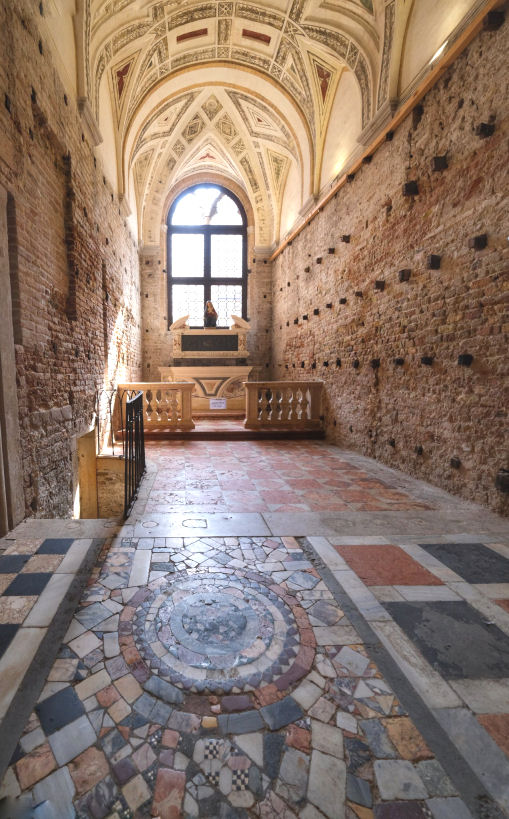 much scholarly debate over its original and subsequent position. It is
now over the altar, designed by Vittoria, and installed at the same time
as the altarpiece and the stalls. To the right of the
altar is The Flight into Egypt by Domenico Tintoretto, and there's
a lunette of the Resurrection of Christ with Adam and Eve by him in
here too. The
Crucifixion over the entrance door is claimed to be by Anthony van
Dyke and very redolent of the counter-reformation in its minimalness and
drama. much scholarly debate over its original and subsequent position. It is
now over the altar, designed by Vittoria, and installed at the same time
as the altarpiece and the stalls. To the right of the
altar is The Flight into Egypt by Domenico Tintoretto, and there's
a lunette of the Resurrection of Christ with Adam and Eve by him in
here too. The
Crucifixion over the entrance door is claimed to be by Anthony van
Dyke and very redolent of the counter-reformation in its minimalness and
drama.
A door takes you through to the Cappella dell'Addolorata (see
left), where
recent restoration work has discovered impressive marmorino
plasterwork decoration in the vaults from the 1460s, so not 19th-century
work as previously thought.
You then enter
the lovely Chapel of San Tarasio (see photo right).
This chapel was the presbytery and apse of the old nun's church, built in 1440/45 by Gambello.
It was partly built to house the relics of the order, including the bodies
of Saints Zaccaria and Tarasio and became a private
chapel for the nuns after the expansion later in the same century.
Fragments of tile floors from both the 9th-century (under glass at the back of the chapel) and the 12th-century (in front of the altar) are visible.
There are some very impressive frescoes in the vaulting by
the Florentine Andrea
del Castagno. An inscription says
that they were painted in 1442 - in collaboration with a certain
Francesco da Faenza - almost half a century
before the Renaissance finally took root in Venice. They are the
artist's earliest extant work and feature his only signature
(Andreas de Florentia). They were discovered in 1923 and cleaned in
the 1950s. The oddly youthful Saint Luke may be an early
self-portrait of the artist.
In this chapel you'll also find three well-preserved late-gothic
gilded altarpieces by brothers-in-law Antonio Vivarini and Giovanni
d’Alemagna. But the central three panels on the main level of the high altarpiece
(Saints Blaise and Martin, with The Virgin and Child Enthroned in the
centre) are signed and dated 1385 by Stefano di Sant'Agnese and were taken from
another work and
inserted in place of a reliquary in 1839. The two saints flanking
them (Mark and Elizabeth) are by Vivarini however.
There are more
saints (said to have also been added later) in panels on the back, in two
rows (see photo right) behind which panels were kept the depicted
saints' relics. There
is also a recently discovered and restored predella on the front of the
altar, which has been ascribed to Paolo Veneziano.
The very late-gothic style Saint Sabina Triptych is on the left-hand wall and the Polyptych of the
Body of Christ is on the right. Both are signed by Antonio Vivarini and Giovanni d’Alemagna and dated
1443 and are very old-style at a time when the Renaissance was raging in
central Italy. The frescoes and
altarpieces were
all paid for by individual nuns in the 1440s, from the wealthy Foscari
(Elena, the abbess and sister of the reigning Doge Francesco), Donà (Marina and Margharita) and Giustiniani (Agnesina)
families.
The 15th-century wooden statues on brackets on the side walls are Saints Zacharias
and Benedict. They were not originally positioned here but, it has been
suggested, were on the screen in the nun's church as part of a Crucifixion
scene with the polychrome wooden Crucifix until quite recently to be seen in the lower
dome of the main church, but very recently restored and now positioned by
the high altar at ground level.
The colonnaded 10th-century Romanesque crypt (see photo right)
under the Chapel of San Tarasio is another relic of the older church and
the eight tombs of early doges found down there are usually romantically
covered by lagoon water. Ongoing restoration work at the church has the
draining of the crypt planned, and the removal of the concrete floor to
reveal what is below.

Campanile 24m (78ft) manual bells
The first tower was demolished in the 11th Century and rebuilt in the
12th with recycled material. It's pyramid-shaped spire is visible in De
Barbari's map (see right). The spire and belfry collapsed in 1510
and the tower was rebuilt in its current spireless form.
Lost art
An early (c.1562) Paolo Veronese Virgin and Child Enthroned, with Saints
Joseph, Giustina, the young John the Baptist, Francis and Jerome (the Pala Bonaldi)
was looted by Napoleon from the sacristy here in 1797 and returned to the
Accademia in 1815. It looks influenced by Bellini, with a setting reminiscent of
his San Zaccaria altarpiece, but already has Veronese's characteristic
bustle and asymmetry. It was commissioned by Francesco Bonaldo, a procurator of San
Marco, as the altarpiece for the funerary chapel created for his brother
Girolamo and son Giovanni as part of his rebuilding in the sacristy here
in 1562.
All three name saints appear in the altarpiece.
The church in art
Francesco Guardi painted The Visiting Room of the Nuns at San Zaccaria.
The doge's visit to San Zaccaria on Easter Monday by
Gabriel Bella (see right) is in the
Querini Stampalia.
There's also a Canaletto (see right)
in a private collection. John Piper produced a lithograph of the façade in the early 1960s.
The church in literature
Mary Laven's
Virgins of Venice has a lot about the high-born reluctant nuns
here, and their consequent unnunlike behaviour, as does
Convents and the Body Politic in Late Renaissance Venice by Jutta
Gisela Sperling. The convent is also the one in which the heroine is
confined in Michelle Lovric’s novel
The Remedy.
Ruskin wrote
Early Renaissance, and fine of its kind; a Gothic chapel attached
to it is of great beauty. It contains the best John Bellini in Venice,
after that of San G. Grisostomo, "The Virgin, with Four Saints;" and is
said to contain another John Bellini and a Tintoret, neither of which I
have seen.
Henry James wrote
... the Madonna of San Zaccaria, hung in a cold, dim, dreary
place, ever so much too high, but so mild and serene, and so grandly
disposed and accompanied, that the proper attitude for even the most
critical amateur, as he looks at it, strikes one as the bended knee.
Bibliography
In centro et oculis urbis nostre : la chiesa e il monastero
di San Zaccaria
Marcianum Press 1996
Details the recent restoration work and is my source for the old plan
above and the photos of the back of the high altarpiece from the old
church and of the cloisters.
Opening times
Daily 10.00 – 12.00 & 4.00 - 6.00
Sacristy, chapels and crypt.
Where once you paid a nice man a €1.50 entry fee these spaces are now run
by Chorus and are open
11.30 - 5.00. But you can now get in with your Chorus pass, and it's the
same man.
Cloister access
It is reportedly possible to see the two cloisters (see below) of the convent if you
ask the Carabinieri nicely. There has also been art for sale in the rooms
in the ex-convent behind the small fenced garden to the right of the
church's entrance.
But not recently. Rooms created out of the area just behind the
entrance to the old church are currently shamefully just used for storage.
Vaporetto San Zaccaria
map

|
|

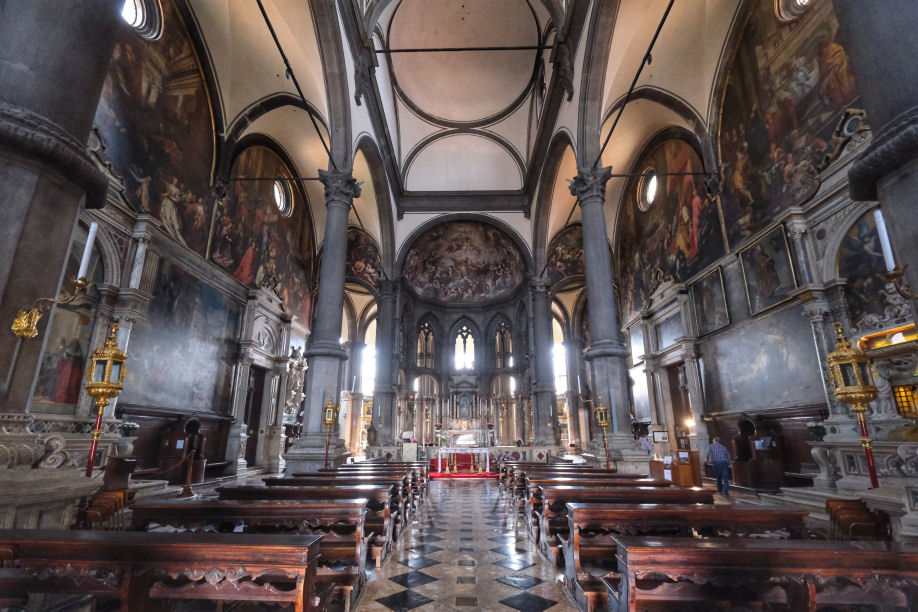
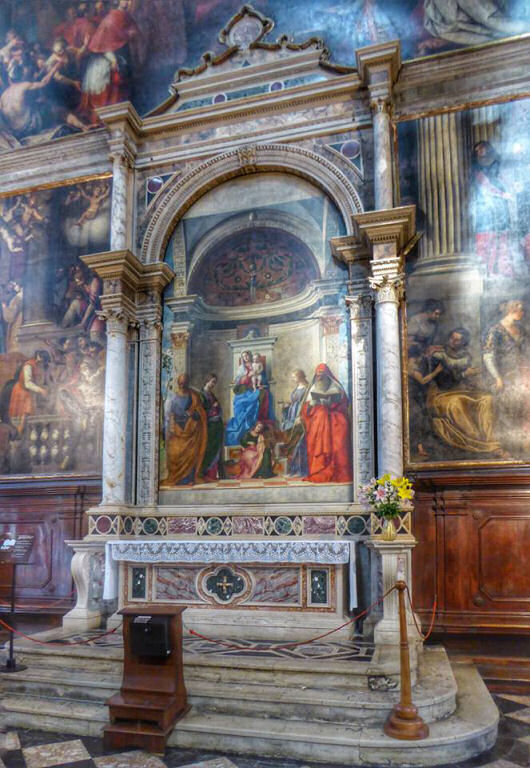
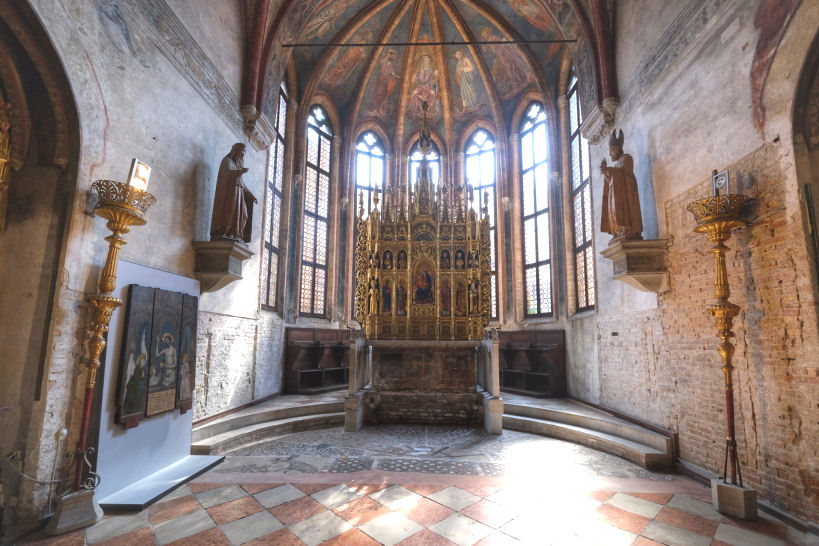
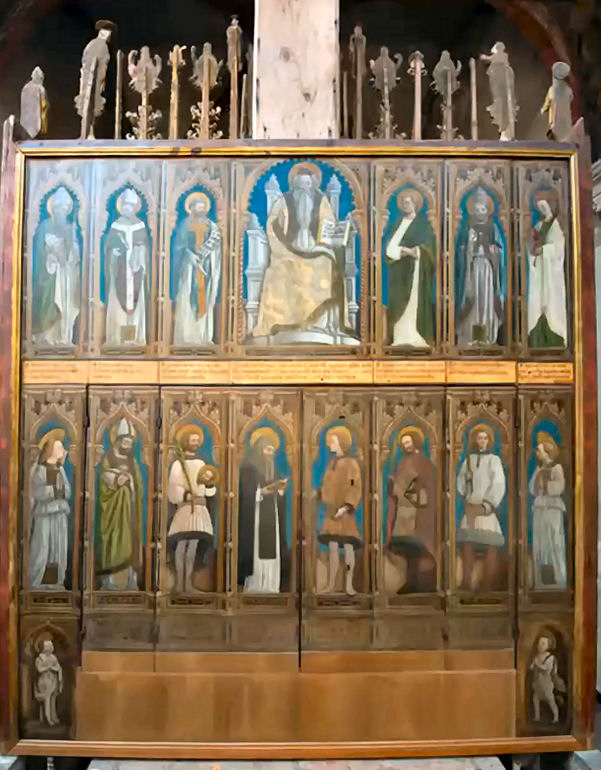

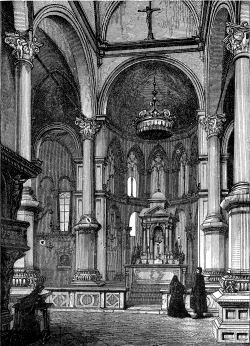
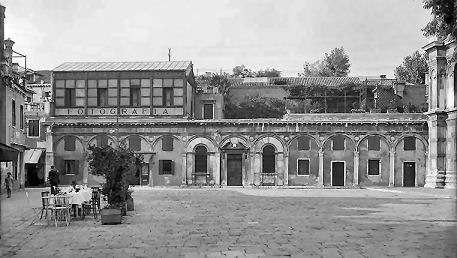
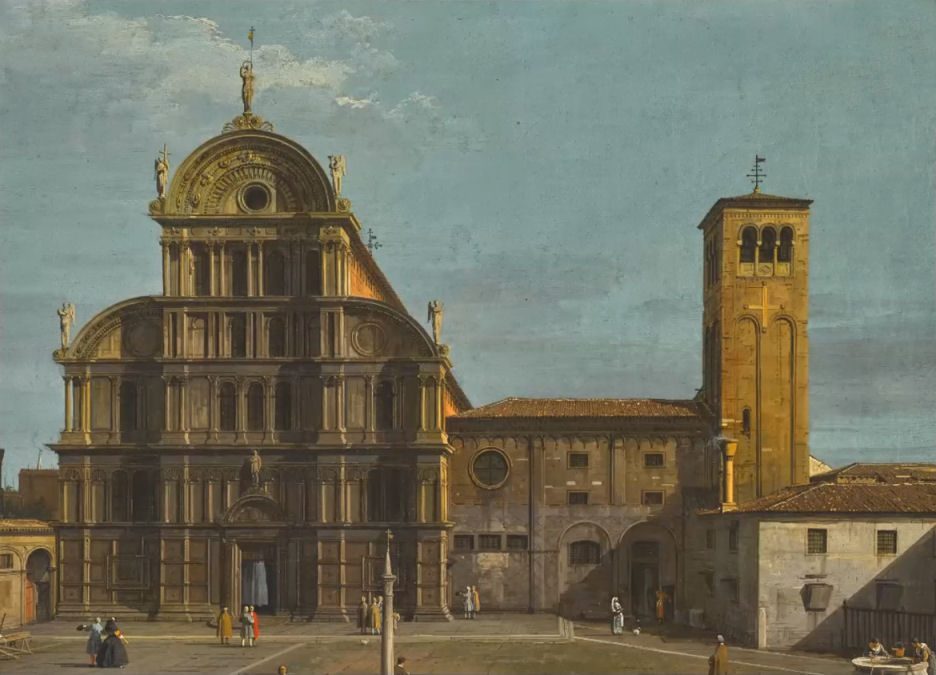
|

